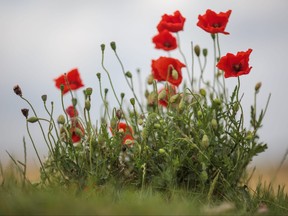Seven newly identified soldiers reburied in Ypres

New Fundland Regiment's Canadian civilian John Lambert killed on August 16, 1917 Ypres, Belgium, was buried nearby.
His body was discovered more than 100 years later by a worker building a gas pipeline near a town in the heart of Flandersfields. Shell-churn landscape of hell.
British and Canadian authorities have given Lambert and six other World War I soldiers a full military burial. Five of the bodies were from unknown British soldiers, and one unknown German soldier was also re-burial. The ceremony took place Thursday at the Commonwealth War Cemetery at New Irish Farm near Ypres.
"Remember, we reconnect with Private John Lambert. He was a mechanic who earns 40 cents a day ... Apply to earn $ 1 a day and immediately tell his sister I gave him 60 cents a day, "said Rev. Gary Watt.
"He exaggerated his age to respond more positively and easily to the call to serve freedom and democracy," Watt said. "Private John Lambert had a common sense of common good. He knew that complacency did not stop the deprivation of freedom."
Commonwealth The War Cemetery Commission(CWGC) states on its website: Tracked the enemy back to the Hindenburg line. The attack on the village was carried out by the 21st Infantry Brigade. During this attack, Ensign Wordsworth, who belonged to the 21st machine gun company, was killed.
Lambert was identified from DNA.
-

Ottawa celebrates the 105th anniversary of the Battle of Vimmy Ridge
-

History of Keshi — a symbol of 100 years of memory
During the pipeline construction work between 2014 and 2016, a total of 63 sets of World War I soldier remains were discovered by archaeologists.
Archaeologists have discovered artifacts that connect unknown soldiers in Britain and Germany, but it has evolved DNA technology that has made it possible to identify more and more unknown soldiers since World War I. is. He was buried as an unknown soldier earlier this month, but the funeral was held 105 years after the death of the nephew of the English poet William Wordsworth, recently identified by DNA research.
The remains of Osmond Bartle Wordsworth, who temporarily lived in Canada, were re-dedicated at the CWGC's H.A.C. Ext Saint-Men Cemetery near Arras in northern France.
"According to reports from the day of his death, Ensign Wordsworth went to help the gun crew after seeing them struggling to get into place." The CWGC has posted on its website. "He was shot through his chest and buried in Henin-sur-Cojour. His body was not recovered after the war."
— With additional report by National Post

National Post
Thank you for registering.
A welcome email has been sent. If you don't see it, check your junk folder.
The next issue of NPPosted will arrive in your inbox shortly.


